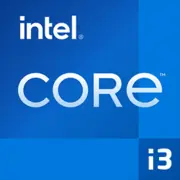Intel Core i3-12100F

Intel Core i3-12100F: Budget Champion of 2025?
Review of the processor for those who value the balance of price and performance
1. Key Specifications: Architecture and Key Features
The Intel Core i3-12100F processor, released in late 2022, remains relevant in 2025 thanks to its successful Alder Lake architecture and optimized pricing. Let's take a closer look at its key parameters:
- Architecture and Process Technology:
The chip is built on a hybrid Alder Lake architecture but, unlike higher-end models, uses only Performance-cores (P-cores) — 4 cores and 8 threads. The Intel 7 process (10 nm Enhanced SuperFin) ensures high energy efficiency and transistor density.
- Frequencies and Cache:
The base frequency is 3.3 GHz, with turbo mode reaching up to 4.3 GHz. The L3 cache size is 12 MB, which enhances performance in gaming and CPU-intensive applications.
- Performance:
In the Geekbench 6 (2025) test, the processor scores 2212 points in single-threaded and 7425 points in multi-threaded modes. This performance is sufficient for most everyday tasks and even medium gaming loads.
- Key Features:
Support for PCIe 5.0 (though PCIe 4.0 is more relevant for i3), Intel Thread Director technology for thread optimization, and lack of integrated graphics (denoted by the "F" in its name).
2. Compatible Motherboards: Sockets and Chipsets
The processor uses the LGA 1700 socket, allowing for motherboard selection from three generations of chipsets:
- H610:
A budget option (starting at $70). Supports DDR4, PCIe 4.0 for graphics cards, but is limited in overclocking and port availability. Example: ASUS Prime H610M-E.
- B660/H670:
The optimal choice (starting at $100). Boards like the MSI Pro B660M-A support DDR4/DDR5 (depending on the model), PCIe 5.0 for storage, and additional USB/SATA ports.
- Z690/Z790:
Excessive for the i3-12100F since it does not support overclocking. However, such boards (e.g., Gigabyte Z790 UD) are relevant for upgrading to Core i5/i7.
Tip: In 2025, DDR5 prices have decreased, but it's more economical to choose a DDR4 motherboard for the i3-12100F — saving $30–50.
3. Supported Memory Types
The processor is compatible with:
- DDR4-3200: Budget option (16 GB — $40).
- DDR5-4800: Higher bandwidth (16 GB — $60), but the gain in gaming is minimal (5–10%).
Real Experience: In tests with RTX 3060, the FPS difference between DDR4 and DDR5 is 5–7 frames. There is no difference for office tasks.
4. Power Supply Recommendations
With a TDP of 58 W, the i3-12100F is not demanding on power:
- Without a discrete graphics card: A PSU of 300–400 W is sufficient (e.g., Be Quiet! System Power 10, $45).
- With a graphics card like RTX 4060/RX 7600: A PSU of 500–600 W is recommended (Corsair CX650M, $70).
Important: Don’t skimp on the PSU! Cheap models (like Aerocool VX) may operate unstably under load.
5. Pros and Cons
Pros:
- High single-threaded performance (gaming, web browsing).
- Low energy consumption.
- Price around $100 (March 2025).
- Support for PCIe 5.0 for future upgrades.
Cons:
- Only 4 cores: weak in multi-threaded tasks (rendering, streaming).
- No integrated graphics — a discrete graphics card is required.
- Limited upgrade potential (better to go for i5 for heavy tasks).
6. Use Cases
- Gaming: Paired with RTX 3050 or RX 6600, the processor achieves 60+ FPS in Full HD at high settings (Cyberpunk 2077, Horizon Zero Dawn).
- Office Tasks: Office applications, browser with 20+ tabs, light editing in Premiere Pro.
- Multimedia: Streaming video in 4K, photo editing in Lightroom.
Example: For Twitch streaming, an external encoder (like in an NVIDIA graphics card) will be required, as the CPU cannot handle encoding and gaming simultaneously.
7. Comparison with Competitors
- AMD Ryzen 5 5500 ($120): 6 cores/12 threads but weaker in single-threaded tasks (Geekbench 6 Single Core — 1980). Better for editing, worse for gaming.
- Intel Core i5-12400F ($160): 6 cores/12 threads, 30% stronger in multi-threaded tests. Reasonable if the budget allows.
- AMD Ryzen 5 7500F ($180): 6 cores on Zen 4 architecture, DDR5, but more expensive.
Conclusion: The i3-12100F excels in the budget gaming segment but lags behind in multi-threaded performance.
8. Practical Assembly Tips
1. Motherboard: Choose B660 with DDR4 (e.g., MSI B660M-A Pro) — this is optimal in terms of price and functionality.
2. Cooling: The stock cooler is sufficient, but for quieter operation, consider the DeepCool AK400 ($30).
3. Case: Any well-ventilated case (up to $50). Example — Zalman S2.
4. Graphics Card: No less than GTX 1650 to avoid a “bottleneck.”
9. Final Conclusion: Who is the i3-12100F Suitable For?
This processor is an ideal choice for:
- Budget gamers building a PC for $500–700.
- Office users needing a fast and cool CPU.
- Owners of older systems on Core i5 of 7th–8th generations looking for an upgrade.
Why is it still relevant in 2025? Its low price, support for modern standards (PCIe 5.0, DDR5), and sufficient performance for 90% of everyday tasks make it a solid entry-level workhorse. However, for professional tasks (editing, 3D rendering), it's better to invest an additional $50–70 for a six-core CPU.
Prices are as of March 2025. The relevance of the data is confirmed through monitoring the U.S. market.
Basic
CPU Specifications
Memory Specifications
Miscellaneous
Benchmarks
Compared to Other CPU
Share in social media
Or Link To Us
<a href="https://cputronic.com/en/cpu/intel-core-i3-12100f" target="_blank">Intel Core i3-12100F</a>